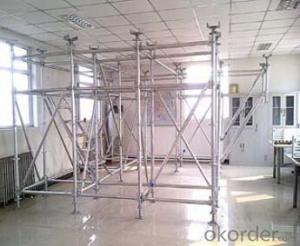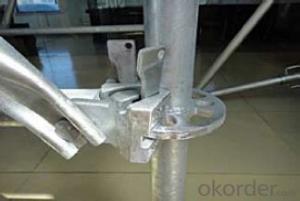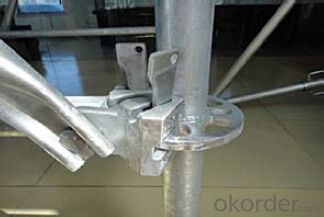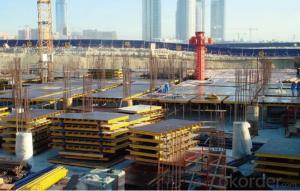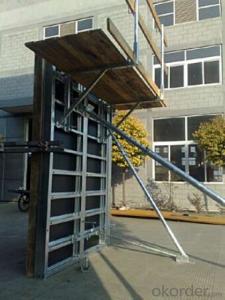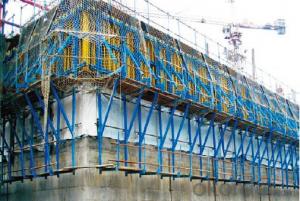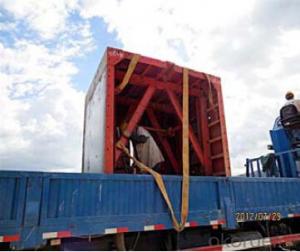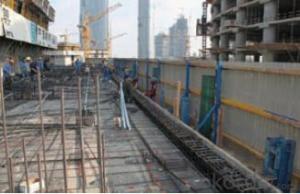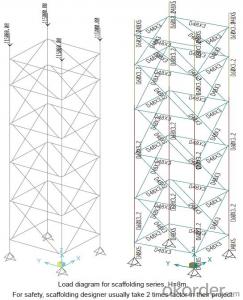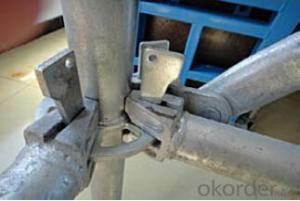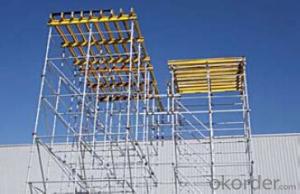Ring-lock scaffolding Accessories for Formwork and scaffolding System
- Loading Port:
- Tianjin
- Payment Terms:
- TT OR LC
- Min Order Qty:
- 50 m²
- Supply Capability:
- 1000 m²/month
OKorder Service Pledge
Quality Product, Order Online Tracking, Timely Delivery
OKorder Financial Service
Credit Rating, Credit Services, Credit Purchasing
You Might Also Like
Ring-lock Scaffolding
A support system for construction, ownsadvantages of both cup-lock scaffolding andshoring tower.
It is in the development direction of new typescaffolding.
It is widely used in buildings, bridges, tunnels etc..
Characteristics:
◆ Easy to storage and transportation
◆ High degree of standardization
◆ Easy and quick erection
◆ Excellent stability and bearing capacity
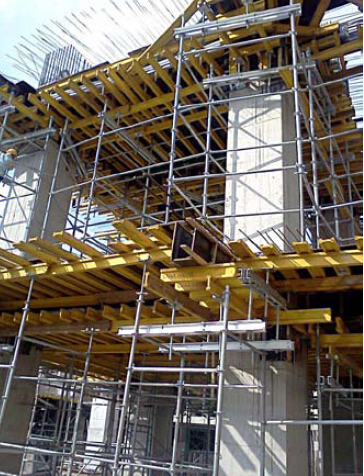
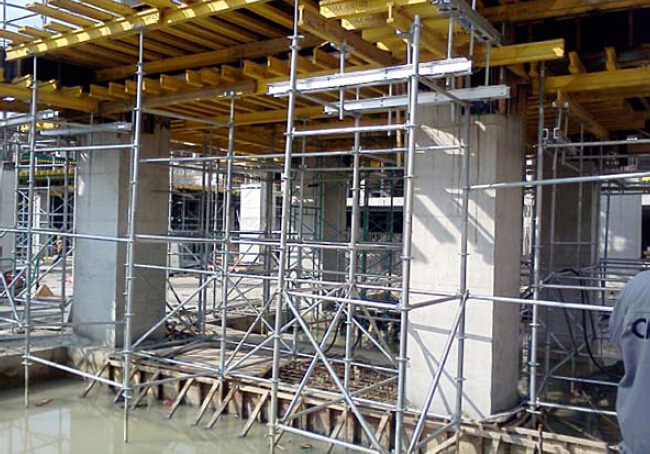
- Q: How does the cost of steel formwork compare to other types of formwork?
- The cost of steel formwork can vary depending on various factors such as the size of the project, the complexity of the structure, and the region where the construction is taking place. However, in general, steel formwork tends to be more expensive compared to other types of formwork. Traditional formwork materials like timber and plywood are usually cheaper and more readily available, making them a popular choice for small to medium-sized projects. These materials offer a lower upfront cost and can be easily cut and shaped to fit the desired form. However, they may not be as durable as steel formwork and may require more frequent replacement or repairs. On the other hand, steel formwork is known for its strength, durability, and reusability. It can withstand high pressures and heavy loads, making it suitable for large-scale projects and structures with complex designs. Steel formwork can be reused multiple times, reducing the overall cost in the long run. While steel formwork may have a higher initial cost, its durability and reusability can result in significant savings over time. Additionally, steel formwork offers advantages such as faster assembly and disassembly, improved safety, and better quality control. Ultimately, the choice between steel formwork and other types of formwork depends on the specific requirements of the project, budget constraints, and the expected lifespan of the formwork. Evaluating the overall cost-effectiveness, durability, and efficiency of each option is crucial in making an informed decision.
- Q: How are steel formwork systems assembled and disassembled?
- Steel formwork systems are assembled by first laying out the required panels and connecting them with pins or bolts. The panels are then aligned and secured using adjustable clamps or wedges. Once the formwork is assembled, reinforcement bars are placed, followed by pouring of concrete. Disassembling the steel formwork involves removing the formwork panels, undoing the clamps or wedges, and carefully dismantling the system in a systematic manner to ensure the safe removal of all components.
- Q: What are the different types of corner solutions available for steel formwork?
- There are several different types of corner solutions available for steel formwork, each with its own advantages and applications. 1. External Corner Solutions: These are typically L-shaped or angled brackets that are used to form external corners in concrete structures. They are easy to install and provide a clean and sharp finish to the corners. External corner solutions are commonly used in building construction, especially for walls and columns. 2. Internal Corner Solutions: Similar to external corner solutions, internal corner solutions are used to form internal corners in concrete structures. They can be either L-shaped or U-shaped brackets, depending on the specific requirements. Internal corner solutions are commonly used in the construction of walls, slabs, and beams. 3. Adjustable Corner Solutions: These are versatile corner solutions that allow for adjustable angles and dimensions. They are designed to accommodate various corner configurations, making them suitable for complex structures or irregular shapes. Adjustable corner solutions are often used in the construction of curved walls, circular columns, and other unique architectural features. 4. Hinged Corner Solutions: Hinged corner solutions are specialized brackets that allow for easy removal of formwork after the concrete has cured. They feature hinges that enable the formwork to be opened and closed, providing quick and efficient access to the concrete surface. Hinged corner solutions are commonly used in applications where frequent access to the concrete surface is required, such as in tunnels or underground structures. 5. Reinforced Corner Solutions: These corner solutions are specifically designed to provide additional strength and support to the corners of concrete structures. They are reinforced with steel bars or plates to enhance the structural integrity and durability of the formwork. Reinforced corner solutions are commonly used in high-rise buildings, bridges, and other heavy-duty structures. Overall, the choice of corner solution depends on the specific requirements of the construction project, including the desired finish, structural integrity, and ease of installation and removal. It is important to consider these factors and consult with a structural engineer or formwork specialist to determine the most suitable corner solution for a particular application.
- Q: Are there any specific quality control measures for steel formwork installation?
- Yes, there are specific quality control measures for steel formwork installation. These measures typically include conducting thorough inspections of the formwork components, ensuring proper alignment and leveling, verifying accurate measurements, and assessing the overall structural integrity before concrete pouring. Additionally, regular monitoring and maintenance of the formwork during the construction process are essential to ensure its stability and durability. Adhering to industry standards and guidelines, such as those provided by the American Concrete Institute (ACI) or relevant local codes, is also crucial to ensure quality control in steel formwork installation.
- Q: Can steel formwork be used for both simple and complex architectural designs?
- Yes, steel formwork can be used for both simple and complex architectural designs. Steel formwork is highly versatile and can be shaped and customized to various shapes and sizes, making it suitable for both simple and complex architectural designs. It offers a high level of flexibility and can be easily adjusted to create intricate and unique forms. Additionally, steel formwork provides excellent strength and stability, allowing it to withstand the pressures and forces exerted during the concrete pouring process. This makes it ideal for constructing structures with complex shapes and designs. Furthermore, steel formwork is durable and reusable, which makes it cost-effective for projects involving both simple and complex architectural designs. Overall, steel formwork is a reliable and efficient solution that can be used in a wide range of architectural designs, regardless of their complexity.
- Q: What are the standard dimensions of steel formwork panels?
- The standard dimensions of steel formwork panels can vary depending on the specific requirements and preferences of the construction project. However, there are common standard dimensions that are widely used in the industry. Typically, steel formwork panels are available in standard lengths ranging from 1 to 3 meters (3 to 10 feet), with a standard width of around 0.6 meters (2 feet). The thickness of the steel panels can also vary, but it is commonly around 12 to 16 millimeters (0.5 to 0.6 inches). These dimensions are designed to provide a strong and sturdy formwork system that can withstand the pressures and forces exerted during concrete pouring and curing. Additionally, these dimensions allow for easy handling and transportation of the formwork panels on the construction site. It is important to note that the dimensions of steel formwork panels can be customized to suit specific project requirements. This flexibility allows for the creation of unique formwork systems that can accommodate various shapes and sizes of concrete structures.
- Q: Can steel formwork be used for projects with aggressive concrete mixes?
- Yes, steel formwork can be used for projects with aggressive concrete mixes. Steel formwork is known for its strength, durability, and resistance to various environmental factors. Aggressive concrete mixes typically contain higher amounts of chemicals such as chlorides, sulfates, or alkalis, which can be corrosive to some materials. However, steel formwork is usually resistant to these aggressive chemical attacks and can withstand the harsh conditions associated with aggressive concrete mixes. It is important to ensure that the steel formwork used is properly coated or treated to enhance its resistance to corrosion and chemical attacks. Regular maintenance and inspection of the formwork are also necessary to identify and address any signs of deterioration or damage. Overall, steel formwork can be a suitable choice for projects with aggressive concrete mixes due to its strength and resistance to chemical attacks.
- Q: Can steel formwork be used for structures with high load-bearing requirements?
- Yes, steel formwork can be used for structures with high load-bearing requirements. Steel formwork is known for its strength, durability, and ability to withstand heavy loads, making it suitable for construction projects that require high load-bearing capacities. It provides stability and support during the concrete pouring process, ensuring that the structure can withstand the required loads once completed.
- Q: What are the different accessories required for steel formwork maintenance?
- The different accessories required for steel formwork maintenance include the following: 1. Formwork cleaning agents: These are used to remove any concrete residue or build-up on the steel formwork. They help in maintaining the smooth surface of the formwork and prevent any damage or corrosion. 2. Formwork release agents: These are applied to the steel formwork before pouring concrete to prevent it from sticking to the formwork. They help in easy removal of the formwork after the concrete has cured. 3. Formwork patching compounds: These are used to repair any damages or imperfections on the steel formwork. They help in maintaining the structural integrity of the formwork and ensure its longevity. 4. Formwork oil or grease: These lubricants are applied to the moving parts of the steel formwork, such as hinges or sliding mechanisms. They help in smooth operation and prevent any friction or wear and tear. 5. Formwork ties and connectors: These are used to secure the formwork panels together and ensure stability during concrete pouring. They should be regularly inspected and replaced if damaged or worn out. 6. Formwork wedges and pins: These are used to align and secure the formwork panels in place. They should be checked regularly to ensure proper positioning and stability. 7. Formwork clamps and brackets: These accessories are used to support and hold the formwork panels in position. They should be inspected for any signs of damage or weakness and replaced if necessary. 8. Formwork cleaning tools: These include brushes, scrapers, and high-pressure washers, which are used to clean the steel formwork. Regular cleaning helps in maintaining the formwork's appearance and prevents the accumulation of dirt or debris. 9. Formwork storage and transportation equipment: These include racks, trolleys, or storage containers, which are used to store and transport the steel formwork safely. Proper storage and transportation ensure the formwork's longevity and prevent any damage or distortion. Overall, the different accessories required for steel formwork maintenance are crucial to ensure the formwork's optimal performance, durability, and safety during concrete construction projects.
- Q: Can steel formwork be used for both above-ground and below-ground structures?
- Yes, steel formwork can be used for both above-ground and below-ground structures. Steel formwork is known for its strength, durability, and versatility, making it suitable for various construction projects. Above-ground structures, such as buildings and bridges, often require formwork to shape and support the concrete during the casting process. Steel formwork provides the necessary strength and stability to withstand the weight and pressure of the concrete. Similarly, below-ground structures like basements, tunnels, and foundations can also benefit from steel formwork. These structures often require formwork to create the desired shape and provide support during the concrete pouring and curing phases. Steel formwork can withstand the pressure exerted by the surrounding soil and groundwater, ensuring the integrity of the structure. Moreover, steel formwork offers advantages such as reusability, easy assembly and disassembly, and the ability to withstand harsh environmental conditions. These characteristics make it an ideal choice for both above-ground and below-ground construction projects, where durability and efficiency are crucial. However, it is important to consider the specific requirements of each project and consult with structural engineers and construction experts to ensure the appropriate formwork system is selected.
Send your message to us
Ring-lock scaffolding Accessories for Formwork and scaffolding System
- Loading Port:
- Tianjin
- Payment Terms:
- TT OR LC
- Min Order Qty:
- 50 m²
- Supply Capability:
- 1000 m²/month
OKorder Service Pledge
Quality Product, Order Online Tracking, Timely Delivery
OKorder Financial Service
Credit Rating, Credit Services, Credit Purchasing
Similar products
Hot products
Hot Searches
Related keywords
